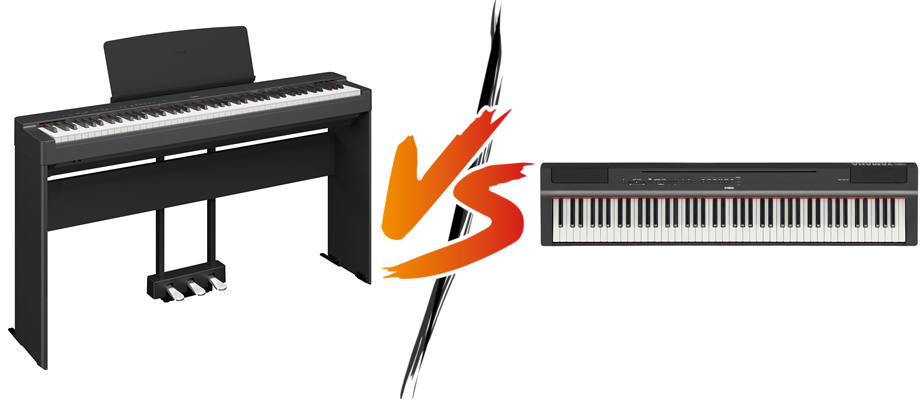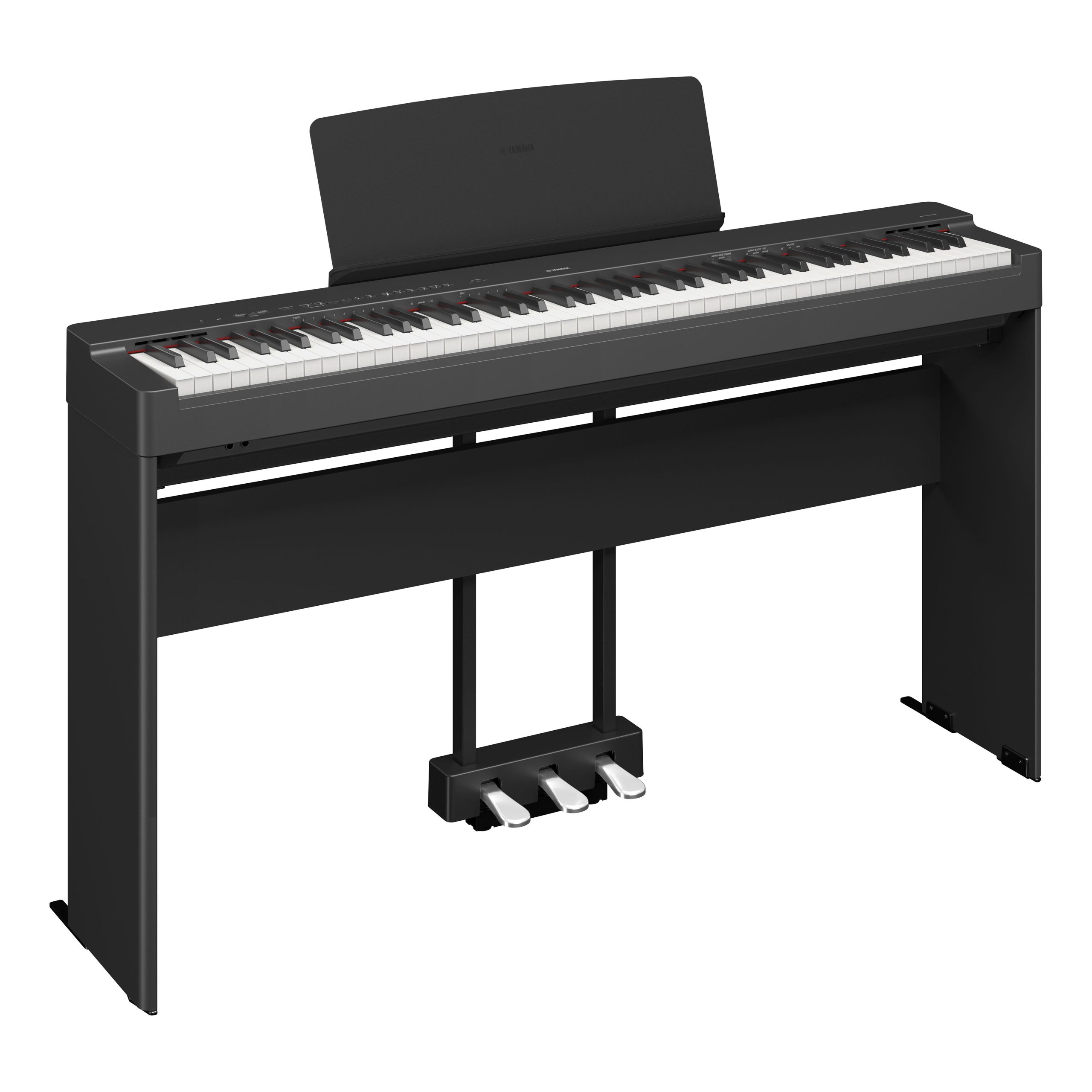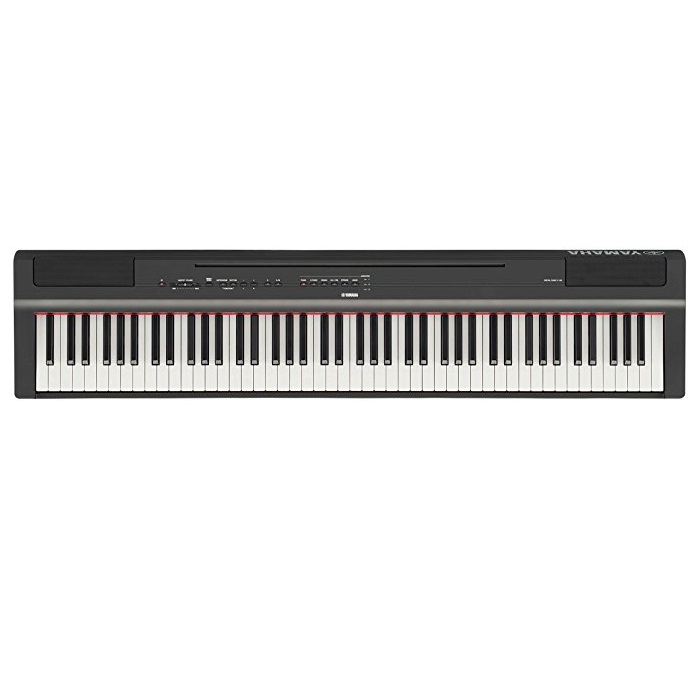
Digital pianos have become an essential tool for musicians at all levels, and Yamaha has been a leader in the field with its extensive range of instruments. Two popular models, the Yamaha P225 and Yamaha P125, are often compared due to their similar features and target audience, but each has its unique strengths and weaknesses. In this in-depth Yamaha P225 vs Yamaha P125 comparison review, I will explore every facet of these two models to help you decide which one suits your needs best. I will analyze their design, keyboard feel, sound quality, speakers, functionality, connectivity, value for money, and other important aspects.
The Yamaha P series has long been known for producing quality digital pianos that cater to both beginners and intermediate players. The Yamaha P125, which has been on the market for a few years, has built a solid reputation for providing excellent sound and performance at a reasonable price. On the other hand, the Yamaha P225, a more recent addition to the P series, promises to bring updated technology and a refreshed design.
Both models are portable digital pianos with 88 keys, and they cater to musicians looking for an authentic piano-playing experience without the bulk of an acoustic piano. However, each has distinct features and performance capabilities that may appeal to different types of players.
Yamaha P225 vs Yamaha P125 Comparison Chart
Below is a detailed comparison table between the Yamaha P225 and the Yamaha P125, highlighting their key specifications and features:
If you click the links below, under the product images you will be redirected to Amazon.com. In case you then decide to buy anything, Amazon.com will pay me a commission. This doesn’t affect the honesty of this review in any way though.
| Feature | Yamaha P225 | Yamaha P125 |
|---|---|---|
 |  | |
| Check best price on Amazon | Check best price on Amazon | |
| Weight | 11.7 kg (25.8 lbs) | 12 kg (26.5 lbs) |
| Dimensions | 1326 x 244 x 79 mm | 1326 x 166 x 295 mm |
| Keyboard | 88 Keys, Graded Hammer Standard (GHS) | 88 Keys, Graded Hammer Standard (GHS) |
| Touch Sensitivity | Hard, Medium, Soft, Fixed | Hard, Medium, Soft, Fixed |
| Sound Engine | Pure CF Sound Engine (Latest Version) | Pure CF Sound Engine |
| Polyphony | 192 notes | 192 notes |
| Piano Voices | Yamaha CFIIIS Concert Grand Piano samples | Yamaha CFIIIS Concert Grand Piano samples |
| Number of Voices | 24 | 24 |
| Modes | Dual, Split, Duo, Sound Boost | Dual, Split, Duo |
| Effects | Reverb, Chorus, Intelligent Acoustic Control (IAC), Sound Boost | Reverb, Intelligent Acoustic Control (IAC) |
| Speakers | 2x (12 cm) + 2x (4 cm) | 2x (12 cm) |
| Amplifiers | 2x 15W | 2x 7W |
| Auto Accompaniment | Yes (Smart Mode) | No |
| Recording | 2-Track Recording | 2-Track Recording |
| Metronome | Yes | Yes |
| Transpose Function | Yes | Yes |
| Tuning Adjustment | Yes | Yes |
| Connectivity | USB to Host, Line Out, Aux In, Bluetooth Audio | USB to Host, Aux In |
| MIDI Compatibility | Yes (USB-MIDI) | Yes (USB-MIDI) |
| Bluetooth | Yes (Audio streaming and app control) | No (Requires external adapter) |
| App Integration | Yamaha Smart Pianist App | Yamaha Smart Pianist App |
| Pedal Support | 1 pedal (included), 3-pedal unit support (optional) | 1 pedal (included), 3-pedal unit support (optional) |
| Headphone Outputs | 2x Stereo (1/4″) | 2x Stereo (1/4″) |
| Price Range | Higher (approx. $800-$900) | Lower (approx. $650-$750) |
| Yamaha P225 review | Yamaha P125 review |
Key Differences Highlighted:
- Design and Portability: The P225 is slightly lighter and more compact, which makes it more portable.
- Sound Engine: The P225 has an updated version of the Pure CF Sound Engine, leading to richer tones.
- Speakers and Amplifiers: The P225 has an improved speaker system (2-way) and more powerful amplifiers, resulting in better sound projection.
- Auto Accompaniment: The P225 includes smart auto-accompaniment, a feature not present in the P125.
- Connectivity: The P225 offers Bluetooth audio and a line-out option, whereas the P125 lacks built-in Bluetooth and only uses a headphone jack for audio output.
Design and Build Quality
Aesthetics
Yamaha P225:
The Yamaha P225 boasts a sleek, modern design that looks slightly more refined than the P125. It has a more minimalist aesthetic, featuring clean lines, fewer visible buttons, and a more contemporary feel. The control panel has been streamlined to offer a more user-friendly interface without compromising functionality. This makes the P225 an appealing choice for those who prefer a simple, elegant design that looks good in any living space.
Yamaha P125:
The Yamaha P125, while still modern, has a slightly more traditional look compared to the P225. It has a busier control panel with more physical buttons, which some users might appreciate for quick access to certain functions. However, compared to the P225, it looks slightly dated due to its design language, but it is still visually appealing.
Portability
Both the Yamaha P125 and P225 are marketed as portable digital pianos, but there are slight differences in their portability.
Yamaha P225:
One of the key selling points of the P225 is its lightweight design. Weighing only about 11.5 kg (25 lbs), it’s easy to transport, making it a great option for gigging musicians or those who need to move their piano between practice spaces. Despite its lightweight build, it doesn’t feel flimsy, thanks to Yamaha’s engineering.
Yamaha P125:
The P125 is a little heavier than the P225, weighing in at around 12 kg (26.5 lbs). While the difference isn’t huge, it’s noticeable if you frequently transport your piano. The P125 is still considered portable, but musicians who prioritize portability might prefer the P225.
Durability
Yamaha P225:
Despite being lighter, the P225 doesn’t compromise on durability. The material used feels sturdy, and it’s built to withstand regular use. The keys are robust, and the overall construction suggests that it will last for years with proper care.
Yamaha P125:
The P125 also has a solid build, typical of Yamaha’s attention to quality. It’s slightly more rugged in its design, which may make it feel more durable to some users. However, the heavier weight could make it slightly more prone to damage during transport if not handled carefully.
Keyboard Action and Feel
For many pianists, the feel of the keys is one of the most important aspects of any digital piano. Both the P225 and P125 come with Yamaha’s well-known Graded Hammer Standard (GHS) action, but there are subtle differences that affect the overall playing experience.
Key Action
Yamaha P225:
The P225 features a slightly improved GHS action compared to the P125. The keys are weighted to mimic the feel of an acoustic piano, with heavier resistance in the lower registers and lighter resistance in the higher registers. The action feels smoother on the P225, and the overall response is a bit more refined. This makes the P225 feel more responsive and comfortable, especially for long practice sessions or performances.
Yamaha P125:
The P125 also uses the GHS action, but some players have noted that it feels slightly stiffer compared to the P225. This could be a matter of personal preference, but the P125’s key action, while still very good for its price range, feels a bit less natural compared to the newer P225.
Key Sensitivity and Responsiveness
Both models offer adjustable touch sensitivity, allowing players to tailor the response of the keys to their playing style. However, the P225 appears to have slightly more nuanced control over key sensitivity.
Yamaha P225:
The P225 offers three levels of touch sensitivity (hard, medium, and soft), plus an off setting, allowing for greater customization. The response is very consistent, making it ideal for dynamic playing, whether you’re performing classical pieces or more contemporary music.
Yamaha P125:
The P125 also has adjustable touch sensitivity with the same number of levels, but the response feels a bit less refined compared to the P225. It still offers a good range of dynamics, but some users may find the P125 slightly less responsive when compared side by side with the P225.
Sound Quality
Sound quality is one of the most crucial factors when choosing a digital piano, and both the P125 and P225 utilize Yamaha’s renowned sound engine, though there are differences in the overall sound experience.
Piano Sound Engine
Yamaha P225:
The P225 features Yamaha’s latest Pure CF Sound Engine, which samples the sound of the Yamaha CFIIIS concert grand piano. The sound is rich, detailed, and more expressive compared to the P125. The improvement in sound quality is particularly noticeable in the nuances of the lower and middle registers, where the P225 captures more depth and realism. Whether you’re playing softly or with force, the sound remains clean and vibrant, making it a joy to play.
Yamaha P125:
The P125 also uses the Pure CF Sound Engine, and while it provides excellent sound quality, it falls just short of the clarity and richness found in the P225. The P125 delivers a very good piano tone, especially in the higher registers, but can lack the same depth of resonance in the bass notes that the P225 offers.
Polyphony
Both models come with 192-note polyphony, which is more than enough for most pieces of music, including those that involve complex pedal use and rapid note repetition.
Yamaha P225:
With 192-note polyphony, the P225 allows for full, rich sound layers and sustains notes without cutting off prematurely. This makes it ideal for complex performances that involve using both hands, the sustain pedal, and layered sounds.
Yamaha P125:
The P125 also offers 192-note polyphony, and it performs similarly in this regard. However, due to the slightly less detailed sound engine, it may not capture the full range of expression as clearly as the P225 in more demanding pieces.
Tone Variety
Yamaha P225:
The P225 comes with an expanded library of voices compared to the P125. In addition to the high-quality grand piano sounds, it offers a wide range of electric pianos, organs, strings, and more. The additional voices are well-crafted and provide a lot of versatility for different musical genres, from classical to pop and jazz.
Yamaha P125:
The P125 offers a good variety of tones, including acoustic piano, electric piano, organ, strings, and bass. However, the selection is slightly more limited compared to the P225. The sound quality of these voices is still very good, but it lacks the expanded tonal variety and refinement that the P225 brings to the table.
Speaker System
The built-in speaker system plays a major role in how a digital piano’s sound is perceived, especially if you’re not using external amplification.
Yamaha P225:
The P225 has an upgraded speaker system compared to the P125. It uses a two-way speaker design, which helps deliver a more balanced sound with clearer highs and deeper lows. The stereo imaging is also improved, making the sound feel more immersive when playing without headphones. At higher volumes, the P225 maintains clarity without distortion, which is particularly beneficial for live performances in smaller venues.
Yamaha P125:
The P125’s speaker system is also very capable, featuring two 7W amplifiers and dual speakers. While it delivers good
sound, the P225 outperforms it in terms of depth and clarity. The P125’s sound is more than adequate for practice and home use, but it can feel slightly lacking in larger spaces or for more critical listening.
Features and Functions
Built-in Features
Yamaha P225:
The P225 comes equipped with a wide array of built-in features aimed at enhancing the playing experience. It includes:
- Recording and playback options, which are handy for practice or songwriting.
- Built-in metronome, transpose function, and tuning adjustments.
- Split and Dual modes that allow you to split the keyboard into two different instrument sounds or layer two sounds together.
- An auto-accompaniment feature, which provides backing tracks for certain musical styles, making it a useful tool for performance and practice.
Yamaha P125:
The P125 shares many of the same features as the P225, including metronome, recording, and playback. However, it lacks some of the more advanced features, such as auto-accompaniment, and the overall interface is slightly less intuitive. The P125’s Dual and Split modes are present but slightly more cumbersome to access quickly compared to the P225.
Modes and Customization
Both models offer various modes that allow users to customize their playing experience.
Yamaha P225:
The P225 has additional customization options, allowing you to tweak sound settings and modes more deeply. It also includes a Sound Boost function, which enhances the audio output when needed, especially in live performance scenarios.
Yamaha P125:
The P125 has a more straightforward approach to its features, which may appeal to beginners who don’t want to be overwhelmed by too many customization options. However, for more experienced players, the limited ability to adjust certain parameters may feel restrictive.
Connectivity Options
In today’s digital age, connectivity options are crucial for musicians who want to integrate their digital pianos with other devices, software, or systems.
MIDI and Audio Interfaces
Yamaha P225:
The P225 comes with both MIDI and USB-to-host connectivity, making it compatible with various music production software and apps. This makes it a versatile tool for recording and creating music on a computer. It also has a line-out jack, which is useful for connecting the piano to external sound systems during performances without losing audio quality.
Yamaha P125:
The P125 also features MIDI and USB-to-host capabilities, but it lacks a dedicated line-out jack. Instead, it uses the headphone output for external amplification, which may result in a slight loss of sound quality. However, for home use or beginner musicians, this difference may not be significant.
Bluetooth and App Integration
Yamaha P225:
The P225 supports Bluetooth audio, which allows you to stream music directly to the piano’s speakers. It also integrates with the Yamaha Smart Pianist app, giving users greater control over settings, voices, and modes from their smartphone or tablet. The Bluetooth connectivity is a big plus for users who want to play along with tracks or use the piano as a speaker system.
Yamaha P125:
The P125 also works with the Smart Pianist app, but it lacks built-in Bluetooth audio. Instead, you need to use an external adapter for Bluetooth functionality, which adds a bit of complexity to the setup. For users who value seamless wireless integration, the P225 has a clear advantage.
Value for Money
When considering value for money, it’s important to weigh the features, sound quality, and overall performance of each model against its price point.
Yamaha P225:
The P225 is priced slightly higher than the P125, but it offers a more refined playing experience, better sound quality, and improved functionality. For intermediate players or professionals looking for a high-quality, portable digital piano, the P225 justifies its higher price tag with its enhanced features and performance.
Yamaha P125:
The P125 is one of the best options in its price range for beginner and intermediate players. It provides excellent sound quality, a good range of features, and a solid build at a very affordable price. While it may lack some of the refinements found in the P225, it’s hard to beat the value it offers for its price.
Pros and Cons of Each Model
Yamaha P225
Pros:
- Improved sound engine with richer tone and depth.
- Lightweight and highly portable.
- Expanded connectivity options, including Bluetooth and line-out jack.
- More intuitive and streamlined design.
- Enhanced speaker system.
Cons:
- Higher price point than the P125.
- May be overkill for beginners who don’t need advanced features.
Yamaha P125
Pros:
- Excellent value for money.
- Solid sound quality for its price range.
- Great beginner-friendly interface.
- Reliable and durable build.
Cons:
- Lacks the advanced connectivity options of the P225.
- Speaker system is not as powerful or refined as the P225.
- Slightly heavier and bulkier.
Conclusion: Which One Should You Buy?
Choosing between the Yamaha P225 and the Yamaha P125 comes down to your specific needs and budget.
- If you’re an intermediate or professional musician who values portability, advanced features, and the highest sound quality in a compact digital piano, the Yamaha P225 is the clear winner. Its improved key action, better speaker system, and expanded connectivity options make it an excellent investment.
- If you’re a beginner or a musician on a budget, the Yamaha P125 offers fantastic value for money. It delivers excellent sound quality and a solid playing experience at a fraction of the cost, making it a great choice for those who don’t need all the advanced features of the P225.
Ultimately, both models represent Yamaha’s commitment to quality, and either choice will serve you well depending on your needs and preferences.
